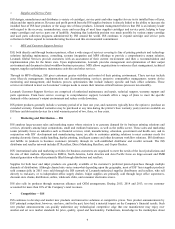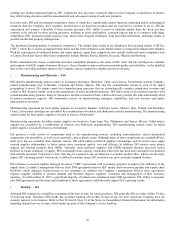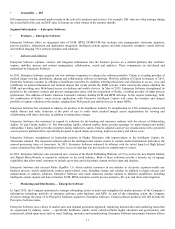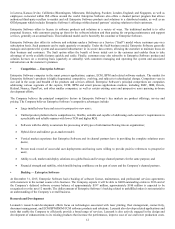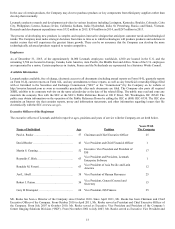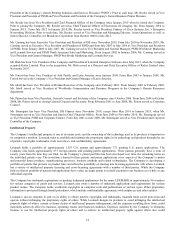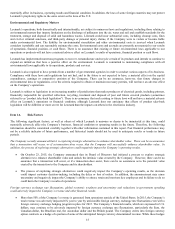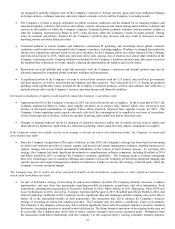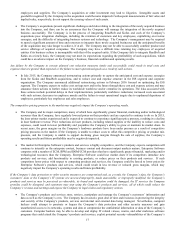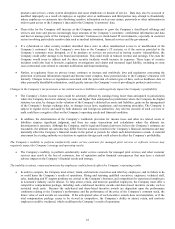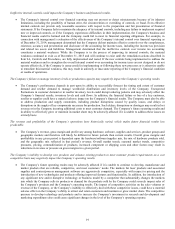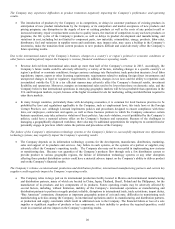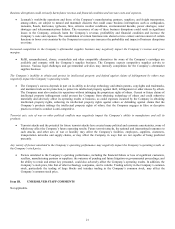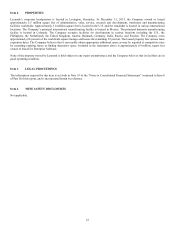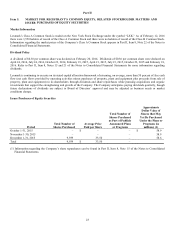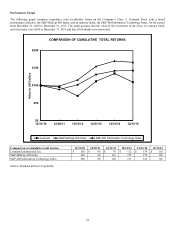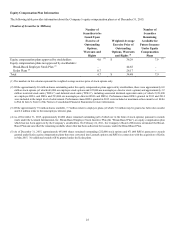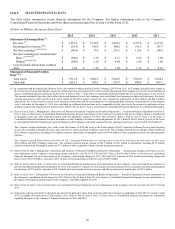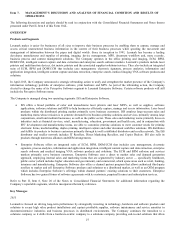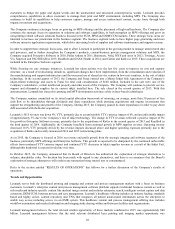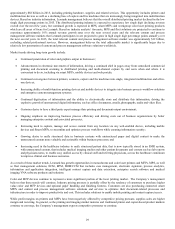Lexmark 2015 Annual Report Download - page 23
Download and view the complete annual report
Please find page 23 of the 2015 Lexmark annual report below. You can navigate through the pages in the report by either clicking on the pages listed below, or by using the keyword search tool below to find specific information within the annual report.19
Ineffective internal controls could impact the Company's business and financial results.
The Company's internal control over financial reporting may not prevent or detect misstatements because of its inherent
limitations, including the possibility of human error, the circumvention or overriding of controls, or fraud. Even effective
internal controls can provide only reasonable assurance with respect to the preparation and fair presentation of financial
statements. If the Company fails to maintain the adequacy of its internal controls, including any failure to implement required
new or improved controls, or if the Company experiences difficulties in their implementation, the Company's business and
financial results could be harmed and the Company could fail to meet its financial reporting obligations. For example, in
connection with management’s evaluation of the effectiveness of the Company’s internal control over financial reporting as
of December 31, 2014, management determined that the Company did not maintain effective controls over the completeness,
existence, accuracy and presentation and disclosure of the accounting for income taxes, including the income tax provision
and related tax assets and liabilities. Management determined that the ineffective controls over income tax accounting
constitutes a material weakness. While the Company is in the process of improving its internal controls, the material
weakness continued to exist as of December 31, 2015 and will continue to exist until the remediation actions described in
Item 9A, Controls and Procedures, are fully implemented and tested. If the new controls being implemented to address the
material weakness and to strengthen the overall internal control over accounting for income taxes are not designed or do not
operate effectively, if the Company is unsuccessful in implementing or following these new processes or is otherwise unable
to remediate this material weakness, this may result in untimely or inaccurate reporting of the Company’s financial condition
or results of operations.
The Company’s failure to manage inventory levels or production capacity may negatively impact the Company’s operating results.
The Company’s performance depends in part upon its ability to successfully forecast the timing and extent of customer
demand and reseller demand to manage worldwide distribution and inventory levels of the Company. Unexpected
fluctuations in customer demand or in reseller inventory levels could disrupt ordering patterns and may adversely affect the
Company’s financial results, inventory levels and cash flows. In addition, the financial failure or loss of a key customer,
reseller or supplier could have a material adverse impact on the Company’s financial results. The Company must also be able
to address production and supply constraints, including product disruptions caused by quality issues, and delays or
disruptions in the supply of key components necessary for production. Such delays, disruptions or shortages may result in lost
revenue or in the Company incurring additional costs to meet customer demand. The Company’s future operating results and
its ability to effectively grow or maintain its market share may be adversely affected if it is unable to address these issues on
a timely basis.
The revenue and profitability of the Company’s operations have historically varied, which makes future financial results less
predictable.
The Company’s revenue, gross margin and profit vary among hardware, software, supplies and services, product groups and
geographic markets and therefore will likely be different in future periods than current results. Overall gross margins and
profitability in any given period is dependent upon the hardware/software/supplies mix, the mix of hardware products sold,
and the geographic mix reflected in that period’s revenue. Overall market trends, seasonal market trends, competitive
pressures, pricing, commoditization of products, increased component or shipping costs and other factors may result in
reductions in revenue or pressure on gross margins in a given period.
The Company’s inability to develop new products and enhance existing products to meet customer product requirements on a cost
competitive basis may negatively impact the Company’s operating results.
The Company’s future operating results may be adversely affected if it is unable to continue to develop, manufacture and
market products that are reliable, competitive, and meet customers’ needs. The markets for laser products and associated
supplies and content/process management software are aggressively competitive, especially with respect to pricing and the
introduction of new technologies and products offering improved features and functionality. In addition, the introduction of
any significant new and/or disruptive technology or business model by a competitor that substantially changes the markets
into which the Company sells its products or demand for the products sold by the Company could severely impact sales of
the Company’s products and the Company’s operating results. The impact of competitive activities on the sales volumes or
revenue of the Company, or the Company’s inability to effectively deal with these competitive issues, could have a material
adverse effect on the Company’s ability to attract and retain customers and maintain or grow market share. The competitive
pressure to develop technology and products and to increase the Company’s investment in research and development and
marketing expenditures also could cause significant changes in the level of the Company’s operating expense.


